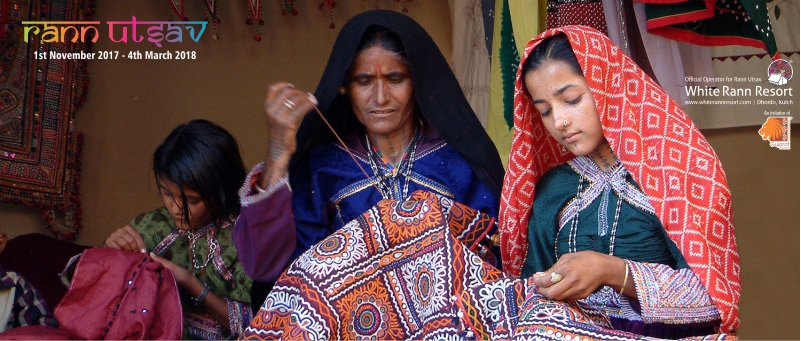Jat Among the three Jat embroidery types that belong to three sub-groups of Jat Community, Garasia Jat Embroidery is very famous and scrupulous. This type of embroidery covers the entire fabric with the tough enough stitches. The fabric is first outlined in white stitches and completed with an arrangement of tiny mirror work and the cross-stitch.
Mutwa
Mutwas are versed in five different embroidery styles, consisting of geometry and floral patterns. The signature trait is a confluence of tiny mirrors and minute stitches.
Mirror Work
Merchants and travellers from the Middle East introduced mirror work (locally known as Abhla-kam) to Guajrat in the 13th century. Mirror work is developed into a sophisticated skill and an integral part of embroidery and patchwork.
The region is also famous for its Ajrakh Block Printing, Rogan, Bandhani, Tie & Dye, Batik, Mirror Work, Applique and Patchwork, Carved Wood, Copper Coated Metal Bells, Handloom weaving, Kharad, Lac Turned Wood, Leather Work, Mashroo, Clay Relief Work, Pottery, Mud Craft, Namda and Silver Craft among many other arts of the region.
Rogan
Rogan painting is a unique craft and practiced by very few families. Rogan painting involves the use of a thick paste, which is prepared by boiling the oil of safflower, caster or linseed and pouring it into water. This paste is mixed with chalk colour pigment and a binding agent to form a thick dye. The painting on the cloth is done using a stick rod or a metal block. Geometric and floral designs are the norm. Red, blue and yellow are the usual colours that are employed. Rogan printing is used for decorating wall hangings, table-cloth, curtains, sarees and skirt borders.
Visit Rann Utsav Booking




 21 September, 2017
21 September, 2017

